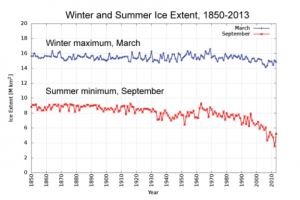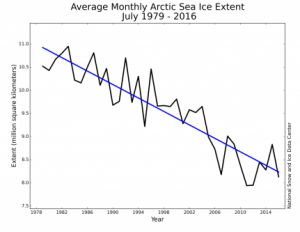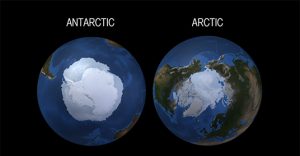31 August 2016
A note on Arctic sea ice loss
Posted by larryohanlon
This is the latest in a series of dispatches from scientists and education officers aboard the National Science Foundation’s R/V Sikuliaq. Read more posts here. Track the Sikuliaq’s progress here.
By Kim Kenny
We probably won’t see much of this view during our trip – fragments of ice in the ship’s wake, a thin white sheet stretching to the horizon. We’re more likely to see the endless blue of 2°C (35°F) water uninterrupted by its frozen state. That’s because the Arctic has been experiencing record low levels of sea ice in the past few years, and this year is no different.
Though it likely won’t be the lowest year on record (that title goes to 2012), 2016 has already been shown to have abnormally low levels of sea ice. Scientists have been using satellites to look at the square area of sea ice since the 1980s, and the master of such monitoring is the National Snow and Ice Data Center (NSIDC).

This graph shows a best estimate of ice extent and sea ice departure from average for the period 1850 to 2013. Credit: NOAA at NSIDC.
According to NSIDC, the current downward trend in Arctic sea ice has no precedent since 1980. Both the winter highs and the summer lows are lower:
You don’t need any mastery of graphical subtlety to see the downward trend for July over the past three decades:
Of course, ice cover in the Arctic does change seasonally, decreasing in the warmer summer months and returning in force as fall gives way to winter. And these changes aren’t always easy to predict – the ice doesn’t return to a set place each year; it is not a permanent geographic feature. The Arctic is especially dynamic, perhaps more so than its cousin on the opposite end of the Earth. They say Antarctica (think: South Pole, virtually uninhabited, and Morgan Freeman’s omniscient voice to the march of emperor penguins) is a continent surrounded by ocean, whereas the Arctic is ocean surrounded by continents. The United States, Canada, Finland, Greenland, Iceland, Norway, Russia, and Sweden remain, while the ice shifts at the whim of the winds and sea.
To give you a better idea of how ice fluctuates in the Arctic, check out this animation published by NASA Goddard’s Scientific Visualization Studio/Cindy Starr a couple weeks ago showing “the new normal” of low sea ice:
Another picture of the new normal, more specifically of the Pacific Arctic, is described in the latest Synthesis of Arctic Research (SOAR) report. More than 100 Arctic scientists and local experts worked together over several years to explore three themes of change in the Pacific Arctic:
“The first is observations and models of sea ice loss and effects on primary production—the ability of organisms at the base of the food web to synthesize organic compounds from carbon dioxide. The second is the response of middle trophic species, such as forage fishes, to the new state of the Arctic. Rounding out the synthesis is the third theme: responses of top-level predators—seabirds, seals, walruses, and whales [Moore and Stabeno, 2015].”
One of the main findings was that the length of the summer open-water period will continue to increase – meaning less ice for longer. The entire report is summarized in this article by marine scientists Lisa Sheffield Guy, Sue E. Moore, and Phyllis J. Stabeno in the American Geophysical Union’s publication, Eos.
The next and final part of the SOAR collaboration will culminate in a new special issue of the journal Deep-Sea Research Part II: Topical Studies in Oceanography.
Safe to say that Arctic sea ice loss is a hot topic right now. The news that sea ice is decreasing may not be a surprise at this point, but it’s important to keep in mind that this change has defined the research careers of many polar scientists. And sea ice is changing so rapidly that they’re scrambling to keep up. What is the extent of sea ice loss, when and where is it happening and how can that help us predict where and when it’ll happen in the future? How will the rest of the Arctic adapt to these changing conditions? Who are the winners and losers? What will be the ripple effects felt throughout the globe? As our research teams jump into their often detail-oriented work, it’s important to keep these larger questions in mind.
Kim Kenny is a freelance journalist who specializes in science writing and multimedia. This post was originally published on thedynamicarctic.wordpress.com





 GeoSpace is a blog on Earth and space science, managed by AGU’s Public Information staff. The blog features posts by AGU writers and guest contributors on all sorts of relevant science topics, but with a focus on new research and geo and space sciences-related stories that are currently in the news.
GeoSpace is a blog on Earth and space science, managed by AGU’s Public Information staff. The blog features posts by AGU writers and guest contributors on all sorts of relevant science topics, but with a focus on new research and geo and space sciences-related stories that are currently in the news.